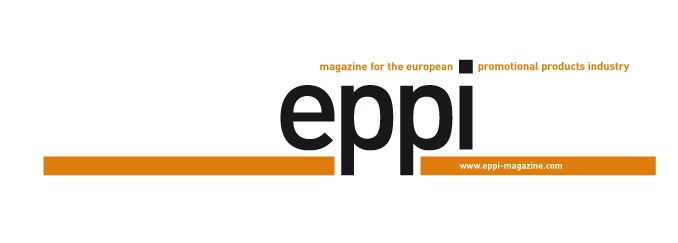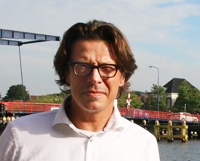The publishing company and exhibition organiser, Het Portaal Uitgevers, has been the communication platform of the Dutch promotional products industry for almost 20 years. eppi magazine spoke with John Swaab, the co-founder, owner and CEO, at the offices of the publishing company in Wormer, about shy professionals, cheeky employees and tradition-conscious disruptors.
Het Portaal Uitgevers resides in a picturesque office in an old warehouse building made of bricks and steel with a view over the river Zaan, a typical bascule bridge and the small city of Wormer, which is located several kilometres north of Amsterdam. In the old days, rice was stored where magazines are made and exhibitions planned today. Here, in the commuter belt of the capital city, was where the heart of the Dutch trade beat. An appropriate environment to do media for the trading sector.
Mr. Swaab, there wasn’t a specific medium for haptic advertising in the Netherlands for a long time. How did you change this?
John Swaab: In the 1990s I worked for RAI Langford, the publishing shoot-off of the Amsterdambased exhibition company, RAI. RAI organised among others the trade show Sale – which was founded by my subsequent partner Hans Janssen – and RAI Langford published a magazine called Incentive, the central emphasis of which lay on Direct Marketing and Sales Promotion, which I canvassed customers for. 80% of the advertising customers were promotional products companies, but the editorial office didn’t want to write articles about promotional products. We made RAI Langford an offer to buy the magazine, but they refused. So, I founded Het Portaal together with Hans Janssen in 1999 and the first publication was the BuyersGuide. The initial issues were printed with a circulation of 12,000 copies. The market reacted thoroughly positively to the fact that there was finally a specialised media for the branch.
What happened next?
John Swaab: Half a year later we renamed the magazine to PromZ magazine. Karin Schaper took over the position of Chief Editor – which she still holds today. In 2001, we extended our portfolio and organised the promotional products show, PromZ Event, for the first time. Then, in 2003, we launched the PromZ Vak, which targeted promotional products resellers. Further magazines and trade fair concepts followed, also for other target groups such as the event industry, for example. Incidentally, Incentive was discontinued several years later – since then we have the monopoly on our market.
You are very familiar with the international promotional products scene, but above all a profound expert on your own market. Which features characterise the industry and the business in the Netherlands?
John Swaab: That we are a trading nation is common knowledge. Many Dutch companies play in the top league at European level – however most of them are suppliers. In the case of the distributors, quite a lot has changed over the past years as a result of the crisis. Many of our advertising customers from the early days no longer exist. The former market leaders are no longer market leaders – small internet specialists with lean structures and innovative strategies have taken their place. After the crisis had a long after-effect in this country, things are eventually starting to pick up again and the more active the companies were over the past years, the better their position today. The Dutch market is characterised by tough competition, at the same time a much more open, communicative climate prevails among the rival companies than in other European markets, where frequently mystery-mongering reigns among the distributors. That is definitely different here. The flat hierarchies are also something that characterises the business. To cite one example: When one of my employees had just started working for us and was still in the trial period, he came to me and said: “Our website is a joke – we really have to do something about it, it is inacceptable!” That would be unimaginable anywhere else, here is it quite normal that one says exactly what one thinks to the boss.
Many of your customers are promotional products suppliers from foreign European countries. What advice do you give them if they want to get going in the Netherlands?
John Swaab: There is a big market here for you – but you will have to sell yourselves well and first of all make sure you make a name for yourself. Many suppliers, who are well-established on their home market take it for granted that they are also known in this country too. That is a mistake – it is important that one first of all explains, who one is and what one stands for. This includes i.e. having a catalogue, if possible in Dutch, which tells the company’s history and not just lists down the products. I find it unfavourable to be represented by another company locally – it is better to hold the strings oneself. Companies that do good PR work and who can fall back on a good back-office don’t even need a Dutch salesman.
You too are active beyond the Dutch borders: You publish a magazine called Promo- Biss for the Belgian promotional products market. Are there regional differences that one has to observe as a publisher?
John Swaab: Yes, huge ones indeed, which is why we have even hired employees locally. The Belgian market works totally different to the Dutch market, in terms of the bilingualism alone, which also bring significant cultural differences with it. In spite of the common language, even the Flemish in the North of Belgium are very different to us Dutch in terms of mentality and culture. The big themes that move our industry are however the same as here and as almost everywhere else in Europe.
What are these themes?
John Swaab: For example the question as to how we can we bring our industry forward. Haptic advertising still ranks right down the bottom of the ladder in terms of reputation, the Sales & Marketing departments still don’t take us seriously. The classic agencies have a great reputation, they are held in high esteem. One can’t say the same about the often no less creative players in our industry – but they are partly to blame themselves here.
What do you mean?
John Swaab: Our sector has a self-esteem problem. Classic advertising agencies are proud about what they do and enjoy talking about it in detail and often. Why do promotional products consultants and suppliers seldom talk about their work? There are so many challenges – a few keywords: Quality, compliance, logistics, process management. Companies that master all this and additionally deliver creative top performances, have every reason to be proud of themselves. We should love our industry more and learn to present it more efficiently. Of course, this takes a certain amount of openness for granted. The market still tends to be more traditional and is marked by its fear of competition. However, companies that operate from a strong position are more successful. All things considered, rather than fighting each other we would all benefit more from coming out of our shells a bit more. The contact between all of the market players, in other words between the suppliers and users is becoming more intense. There’s no stopping this and it is an opportunity for everyone.
Your publishing company recently developed a new concept for two of its presentation platforms, which target users: Instead of the promotional products trade fair PromZ and the RelatieZ, which focused on the Christmas business that is very significant in the Netherlands, the PromZ.live was staged in May for the first time. What is the strategy behind this?
John Swaab: When it comes down to end user fairs, I consider traditional trade fair models to be outdated. Experiences are what is needed. Trade shows have to be fun and offer added value that goes far beyond a mere product show – i.e. through seminars. I don’t believe that trade shows are passé, like some people claim. People still also go to the cinema too – because they want to enjoy that live experience. But indeed we have to actually also deliver that live experience.
Which effects is the progressing digitalisation having on the Dutch market?
John Swaab: The Netherlands was quicker off the mark than other countries when it came down to digitalisation. On the distributor side, there are a host of new players, who are having a disruptive effect and the suppliers – primarily the big importers – are working full steam ahead on their own digitalisation. Pressure that is being exerted from the outside: Many end users don’t see why they should have to wait for days for something as “simple” as an imprint. The trend towards personalisation is also booming, and is being fuelled by revolutionary printing techniques – our selfieloving, individualist society demands the corresponding promotional products. However, this scenario is not necessarily threatening: Not all of the Internet players will survive – at the end the established distributors will prevail, those who succeed in further developing themselves with the support of the supplier partners. The good companies will survive.
How is the digitalisation changing your business as a publishing company and organiser?
John Swaab: We are noticing a shift in paradigms too. Our turnovers for the print advertising business have declined over the past years, on the other hand we are experiencing annual growths in the online sector of between 15% and 20%. Of course, we have to adapt in line with this development. Our job is and will remain to be to connect, inform and push the industry. We know the industry and the themes that move it and we regularly invest in market research so that we remain on the pulse of time and are able to provide current cognitions. There will always be a market for expertise, which in turn is prepared to reward it correspondingly. A few years ago nobody believed that anyone would pay for films and music again in the future and then Netflix and Spotify proved everyone wrong. The need for an industry platform is ongoing. It remains to be seen how we will satisfy this need in future – however the traditional channels still offer invaluable advantages today. For example when it comes down to brand development, print is unbeatable. The requirement for face-to-face contact also remains – why would Cool Blue, one of the biggest Dutch online retailers, be opening up retailer shops otherwise? We are the communication service providers for the Dutch promotional products industry and will keep on fulfilling this task. Personally, I hope that paper never disappears completely.
// Till Barth spoke with John Swaab.
photo: Till Barth, © WA Media




